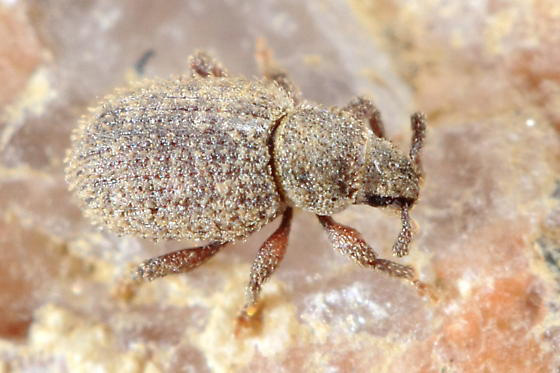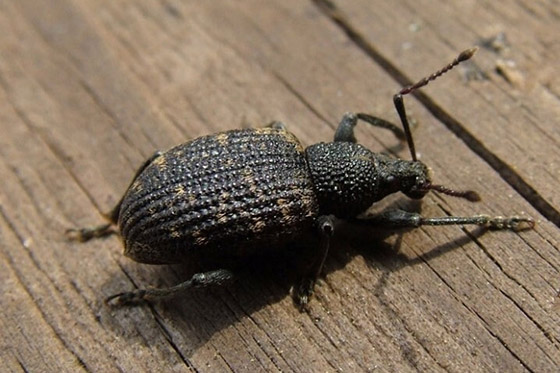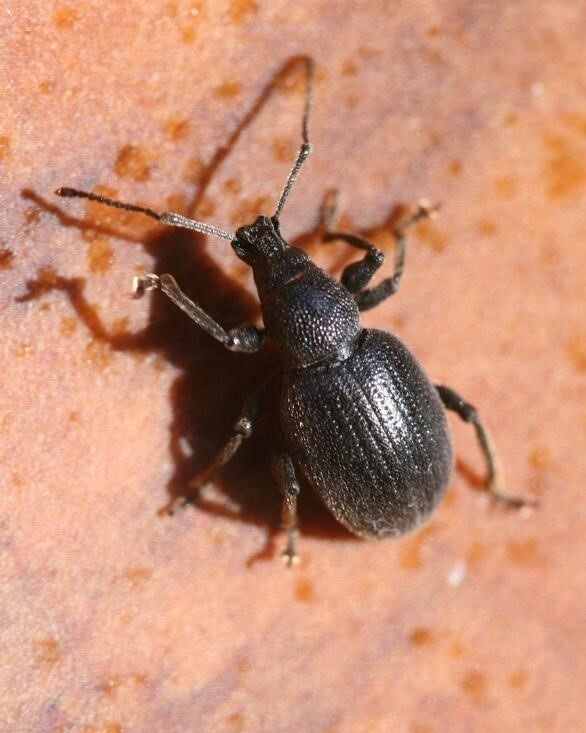Root Weevils (several species)

Figure 1. Cathormiocerus spinosus (Size=2.5mm). Photo by Stephen P.L. Luk, 2016

Figure 2. Black vine weevil (Size=6-8mm). Photo by C. Moorehead, Bugwood.
Montana has several home-invading weevils that come into our homes in April through November. See pictures below. They are harmless to humans and structures.
They are root weevils, and the biology for most species is poorly understood. Several root weevil species are pests on ornamental plants. The most common ones we are seeing right now are small root weevils, Cathormiocerus spinosus (Figure 1).

Root weevil, Otiorhynchus sp.
Hosts
Many deciduous shrubs, inside buildings and homes.
Damage and Symptoms
The characteristic damage from adults includes notching along the leaf margins from chewing (Figure 4). The larvae feed on plant roots. The damage is primarily cosmetic (no treatment necessary).
Management
Cultural/Physical
Most often, no management is necessary. These weevils are difficult to control and can come in by the dozens for a couple weeks at a time in the late summer. Any small opening can allow these beetles to “squeeze” into the building. You will likely want to do the following:
-
- Make sure door sweeps are installed at the base of the exterior doors and that they fit tightly.
- Seal all cracks in siding.
- One point of entry is the meeting of foundation and siding of a building. Caulk or fill this juncture.
- Vacuum up all the adults that you can in the meantime.
Chemical
Chemical controls have not been very effective for these beetles because it is difficult to target their overwintering sites and their point of entry. However, you can do barrier sprays in the early fall to kill the insect before they enter the building. Here are some tips:
-
- The chemical treatments need to be in place before the invasion is in full swing (before late fall).
- The base of all doors and window should be treated.
- Apply materials to a 2-to-6 foot wide band along the soil around the foundation and 2-to-3 feet up the foundation wall.
- Sprays work well on surfaces.
- Granular insecticides or sprays can be used for ground treatments.
Further Information
To learn more about the topics discussed on this page, contact the Schutter Diagnostic Lab. If you suspect an infestation on your property, contact your local extension agent, the Schutter Diagnostic Lab at Montana State University, or the Montana Department of Agriculture.
This fact sheet is also available as a printable PDF (653KB).
Disclaimer: These recommendations are provided only as a guide. It is always the pesticide applicator’s responsibility, by law, to read and follow all current label directions for the specific pesticide being used. The authors and Montana State University assume no liability resulting from the use of these recommendations. The Montana State University Extension Service is an ADA/ EO/AA/Veteran’s Preference Employer and Provider of Educational Outreach.
